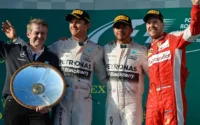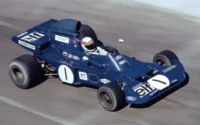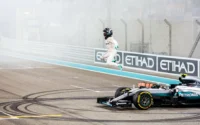The Tyrrell Racing Organisation, founded by Ken Tyrrell in 1958, stands as one of the most historic teams in F1 history. Initially, the team made its mark in Formula 3, Formula 2, and Formula Junior series before stepping up to F1 in 1968.
Notable Team Members and Drivers
Ken Tyrrell (Founder and Team Principal): Ken Tyrrell was the founding figure behind the Tyrrell Racing Organisation. Starting as a timber merchant, he moved into motorsport first as a driver before becoming a team owner and manager. Under his leadership, Tyrrell entered Formula 1 in 1968.
Jackie Stewart (Driver): Sir Jackie Stewart, also known as the “Flying Scot,” was one of the most successful drivers for Tyrrell. Stewart won three World Drivers’ Championships in 1969, 1971, and 1973, all while driving for Tyrrell.
Derek Gardner (Chief Designer): Derek Gardner was the engineering mastermind behind some of Tyrrell’s most innovative cars. He joined the team in 1969 and was responsible for designing the Tyrrell 001, 002, and 003 cars, among others. Perhaps his most famous creation was the Tyrrell P34, the only six-wheeled car ever to win a Formula One Grand Prix.
The team’s approach to car design and strategy was evident from its early seasons, which made a huge impact on the grid. In 1971, Tyrrell introduced the 003 model, powered by a Ford Cosworth DFV engine and driven by Jackie Stewart; the team dominated the season, clinching both the Drivers’ and Constructors’ Championships. While the car was superior to most, it was also Stewart’s exceptional driving skills that led the Tyrrell team to new heights.
Tyrrell’s continued innovation was further demonstrated in 1976 with the introduction of the P34, the only six-wheeled car in F1 history to win a Grand Prix. The P34, with its four small front wheels designed to reduce air resistance and improve grip, remains one of the most distinctive and innovative cars in the sport’s history. Although the six-wheeled design was eventually banned, the Tyrrell P34 will be remembered as pushing the boundaries of conventional design.
Throughout the 1970s and early 1980s, Tyrrell remained a formidable force in Formula One, with drivers such as Jody Scheckter, Patrick Depailler, and Michele Alboreto achieving significant success. However, the team faced increasing challenges in the mid-1980s as F1 changed. The introduction of turbocharged engines and aerodynamic advancements led to increased competition, and Tyrrell struggled to keep pace with these changes and the financial resources it required.
Despite these challenges, Tyrrell remained in Formula One, often focusing on developing young talent. The team was known for its ability to identify and nurture promising drivers, including notable drivers such as Jean Alesi, who cut his teeth in F1 with the team in 1989.
In the late 1990s, the financial pressures and competitive challenges facing independent teams like Tyrrell became too great. In 1998, the team was sold to British American Tobacco. It was rebranded as British American Racing for the 1999 season, marking the end of the Tyrrell Racing Organisation’s involvement in Formula One.
Tyrrell Racing F1 Legacy
The lineage of the 2009 double championship-winning Brawn GP team and the current Mercedes team can trace their origins back to Tyrrell through a series of transformations involving BAR and Honda Racing F1.
BAR’s acquisition of the Tyrrell F1 team marked a departure from the original Tyrrell setup, adopting a new factory, chassis builder, and engine. The equipment and cars from Tyrrell’s era found a new home with Paul Stoddart, who would later become the owner of the Minardi F1 team.
The transition to Brawn GP was initiated by Ross Brawn through a management buyout of the Honda F1 team for the 2009 season. During this period, there was a momentary consideration for reviving the Tyrrell name for the new team.
As of the 2023 Abu Dhabi Grand Prix, the legacy of Tyrrell, through its successors, boasts an impressive tally of 125 Grand Prix victories, 8 Drivers’ championships (with Brawn securing one in 2009 and Mercedes claiming the title from 2014 to 2020), and 9 Constructors’ championships (one with Brawn in 2009 and the remainder with Mercedes from 2014 to 2021).
The 2-seater F1 cars operated by Minardi, a modification of the 1998 Tyrrell 026 design, still grace tracks today. Their unique nose design is particularly notable during demonstrations, including their recent appearance at the inauguration of the Yas Marina F1 track.
Ken Tyrrell, the visionary behind the original Tyrrell Racing Organisation, passed away from cancer on 25 August 2001 at 77 years old.
Tyrrell Racing Formula One World Championship Records
| First entry | 1970 Monaco Grand Prix |
|---|---|
| Races entered | 434 |
| Constructors’ Championships | 1 (1971) |
| Drivers’ Championships | 2 (1971, 1973) |
| Race victories | 23 |
| Podiums | 77 |
| Points | 711 |
| Pole positions | 14 |
| Fastest laps | 20 |
| Final entry | 1998 Japanese Grand Prix |
Tyrrell Racing Drivers’ Champions
The following drivers won the Formula One Drivers’ Championship for Tyrrell Racing.
| Driver | Nationality | Championship Year |
|---|---|---|
| Jackie Stewart | British | 1971 |
| Jackie Stewart | British | 1973 |
Tyrrell Championship Results
| Year | Car | Drivers | Points | WCC |
|---|---|---|---|---|
| 1970 | March 701 001 | Jackie Stewart Johnny Servoz-Gavin | 1 | 10th |
| 1971 | 001 002 003 | Peter Revson Francois Cevert Jackie Stewart | 73 | 1st |
| 1972 | 002 003 004 005 006 | Patrick Depailler Francois Cevert Jackie Stewart | 51 | 2nd |
| 1973 | 005 006 | Chris Amon Eddie Keizan Francois Cevert Jackie Stewart | 82 | 2nd |
| 1974 | 005 006 007 | Eddie Keizan Jody Scheckter Patrick Depailler | 52 | 3rd |
| 1975 | 007 | Michel Leclere Jean-Pierre Jabouille Ian Scheckter Jody Scheckter Patrick Depailler | 25 | 5th |
| 1976 | 007 P34 | Kazuyoshi Hoshino Otto Stuppacher Sandro Pesenti-Rossi Ian Scheckter Jody Scheckter Patrick Depailler | 71 | 3rd |
| 1977 | P34 | Kunimitsu Takahashi Patrick Depailler Ronnie Peterson | 27 | 6th |
| 1978 | 008 | Didier Pironi Patrick Depailler | 38 | 4th |
| 1979 | 009 | Derek Daly Geoff Lees Didier Pironi Jean-Pierre Jarier | 28 | 5th |
| 1980 | 009 010 | Mike Thackwell Derek Daly Jean-Pierre Jarier | 12 | 6th |
| 1981 | 010 011 | Michele Alboreto Ricardo Zunino Eddie Cheever Kevin Cogan | 10 | 10th |
| 1982 | 011 | Brian Henton Michele Alboreto Slim Borgudd | 25 | 6th |
| 1983 | 011 012 | Danny Sullivan Michele Alboreto | 12 | 7th |
| 1984 | 012 | Mike Thackwell Stefan Johansson Martin Brundle Stefan Bellof | ||
| 1985 | 012 014 | Philippe Streiff Ivan Capelli Stefan Bellof Martin Brundle Stefan Johansson | 4 | 9th |
| 1986 | 014 015 | Martin Brundle Philippe Streiff | 11 | 7th |
| 1987 | DG016 | Jonathan Palmer Philippe Streiff | 11 | 6th |
| 1988 | 017 | Jonathan Palmer Julian Bailey | 5 | 8th |
| 1989 | 017B 018 | Johnny Herbert Jean Alesi Jonathan Palmer Michele Alboreto | 16 | 5th |
| 1990 | 018 019 | Jean Alesi Satoru Nakajima | 16 | 5th |
| 1991 | 020 | Satoru Nakajima Stefano Modena | 12 | 6th |
| 1992 | 020B | Andrea de Cesaris Olivier Grouillard | 8 | 6th |
| 1993 | 020C 021 | Andrea de Cesaris Ukyo Katayama | ||
| 1994 | 022 | Mark Blundell Ukyo Katayama | 13 | 7th |
| 1995 | 023 | Gabriele Tarquini Mika Salo Ukyo Katayama | 5 | 9th |
| 1996 | 024 | Mika Salo Ukyo Katayama | 5 | 8th |
| 1997 | 025 | Jos Verstappen Mika Salo | 2 | 10th |
| 1998 | 026 | Ricardo Rosset Toranosuke Takagi |


